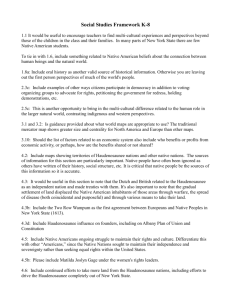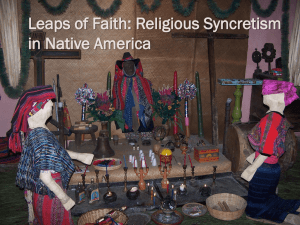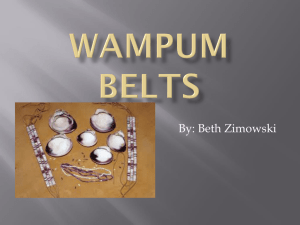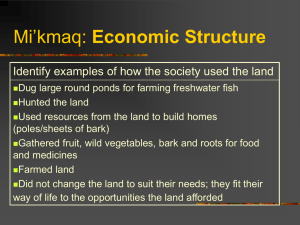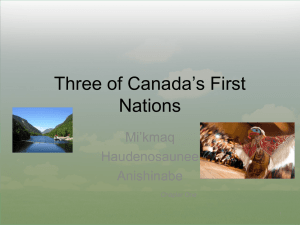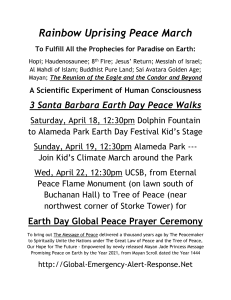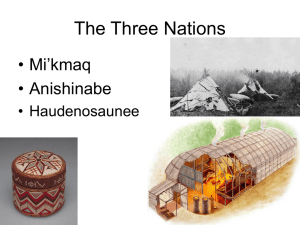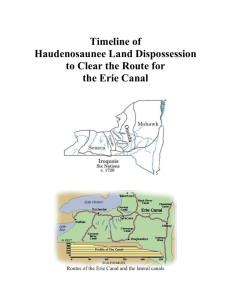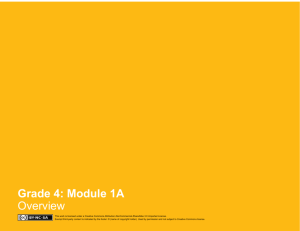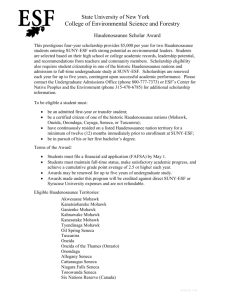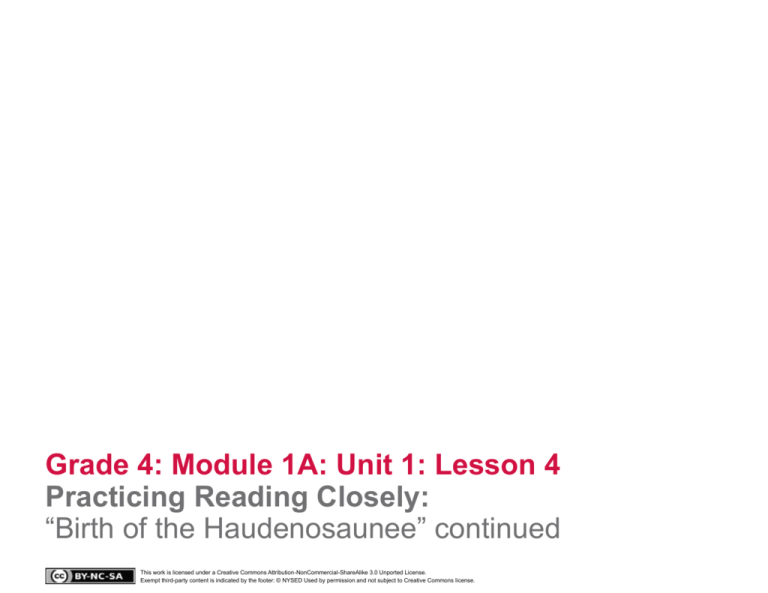
Grade 4: Module 1A: Unit 1: Lesson 4
Practicing Reading Closely:
“Birth of the Haudenosaunee” continued
This work is licensed under a Creative Commons Attribution-NonCommercial-ShareAlike 3.0 Unported License.
Exempt third-party content is indicated by the footer: © NYSED Used by permission and not subject to Creative Commons license.
GRADE 4: MODULE 1A: UNIT 1: LESSON 4
Practicing Reading Closely:
Birth of the Haudenosaunee
Long-Term Targets Addressed (Based on NYSP12 ELA CCLS)
I can explain what a text says using specific details from the text. (RI.4.1)
I can engage effectively in a collaborative discussion. (SL.4.1)
I can compare different versions of the same story (RI.4.7)
Supporting Learning Targets
Ongoing Assessment
• I can answer questions using specific details from a text.
• Student-created graphic organizer
• I can compare a video to a text version of the same story.
• I can demonstrate what I know by contributing to discussions.
Agenda
Teaching Notes
1.
• In advance, prepare a PowerPoint vocabulary lesson using the same format from Lesson 3. Choose 4-5 words
from the text that cannot be figured out using context clues.
Opening
A. Engaging the Reader: Recounting the
Peacemaker Story (5 minutes)
2. Work Time
A. Identifying Symbolism in “Birth of the
Haudenosaunee” (15 minutes)
B. Masterful Reading and Identifying
Symbolism (15 minutes)
• This lesson includes a reread of “Journey of the Peacemaker” with a focus on symbolism and a close read of
Section 2 of the “Birth of the Haudenosaunee”, “Coming Together”, accompanied by the completion of a new
worksheet.
• The second portion of the story includes references to the Haudenosaunee government which will not be directly
addressed here. This lesson may connect and serve as a bridge to lessons in Social Studies.
C. “Keeping Track” Anchor Chart (10
minutes)
D. Comparing Stories (10 minutes)
Closing and Assessment
A. Debrief and Exit Ticket (5 minutes)
3. Homework
Copyright © 2014 by NYSED, Albany, NY. All Rights Reserved
NYS Common Core ELA Curriculum • G4:M1A:U1:L4 • June 2014 •
1
GRADE 4: MODULE 1A: UNIT 1: LESSON 4
Practicing Reading Closely:
Birth of the Haudenosaunee
Lesson Vocabulary
Materials
details, contribute, discussion, notice,
wonder, captions, sovereign, countless,
Hoyane, Gustoweh, headdress,
council, envisioned, govern,
continuous, democratic, complement
• Keeping Track of How it all fits together anchor chart
• “Birth of the Haudenosaunee” Symbolism and Text-Based Answers handout
• “Birth of the Haudenosaunee” (from Lesson 3)
• Teacher-created vocabulary PowerPoint
• Document camera or white board
• Video: The Stone Canoe: The Story of the Peacemaker: http://www.onondaganation.org/news/video/2008/the-stonecanoe-the-story-of-the-peace-maker-2/
• Index cards
Meeting Students’ Needs
Opening
A. Engaging the Reader: Recounting “Birth of the Haudenosaunee” (5 minutes)
• Share the learning targets:
• “I can answer questions using specific details from the text.”
• “I can show what I know by contributing to discussions.”
• Ask students to tell you what they remember from yesterday about the meanings of contribute, details, and discussion.
• Ask students to review their work/reading from yesterday and Think-Pair-Share about what happened so far in the Birth of
the Haudenosaunee. They should also think about any questions they may have about yesterday’s reading. Ask students to
share summaries with the class and answer any questions students may have about the reading so far. This would also be a
good time to review the previous lesson’s exit tickets.
Copyright © 2014 by NYSED, Albany, NY. All Rights Reserved
NYS Common Core ELA Curriculum • G4:M1A:U1:L4 • June 2014 •
2
GRADE 4: MODULE 1A: UNIT 1: LESSON 4
Practicing Reading Closely:
Birth of the Haudenosaunee
Work Time
Meeting Students’ Needs
•
Identifying Symbolism in “Birth of the Haudenosaunee” (15 minutes)
•
Suggestions for vocabulary instruction:
Graphic organizers engage students
more actively and provide the necessary
scaffolding that’s especially critical for
learners with lower levels of language
proficiency.
•
Begin with vocabulary exercise as in Lesson 3. Select words from the lesson vocabulary list that you feel would
most benefit your students and move through them using the vocabulary Power Point.
•
Model for students how to figure out the meaning of a word in context using an example from today’s reading
(recommend “bound” or “bundled” in paragraph 8). Choose a word that is not defined in the Power Point.
•
Inform students that good readers read a complex text more than once in order to understand it more fully. Explain that
they read the section titled “Journey of the Peacemaker” in the previous lesson and answered questions about it. Today
they will read that section again, but with a different purpose. Today they will be looking for symbolism in the text. Review
with students what symbolism is if necessary.
•
Distribute the worksheet “Birth of the Haudenosaunee”: Symbolism and Text-Based Answers to each student.
•
Students should work with the same partner from the previous lesson to answer the questions in the first box. Circulate to
provide support.
•
Review responses to these questions whole class:
•
Label the Tree of Peace and the Hiawatha Belt based on what you read in “Journey of the Peacemaker”. (If
possible, project an image of the Great Peace Tree and the Hiawatha Belt that you can label using student
feedback, or that students can label on a Smartboard.)
•
How does the story explain the symbol of the arrows bound together?
•
How do the Great Peace Tree and the Hiawatha Belt symbolize the Haudenosaunee?
B. Masterful Reading and Identifying symbolism (15 minutes)
•
•
•
Read aloud the section titled “Coming Together”.
After the master read, have students whisper read together in pairs and circulate to check for understanding. Tell them
that if they do not know a word and cannot figure it out, circle or highlight it. They should also underline any details they
think are important to the story. Instruct them to answer the questions in the second box on their “Birth of the
Haudenosaunee” Symbolism and Text-Based Answers handout with their partners when they have completed
the paragraphs.
Have students share out and clarify as needed:
•
What do the antlers on the headdresses represent?
Copyright © 2014 by NYSED, Albany, NY. All Rights Reserved
NYS Common Core ELA Curriculum • G4:M1A:U1:L4 • June 2014 •
3
GRADE 4: MODULE 1A: UNIT 1: LESSON 4
Practicing Reading Closely:
Birth of the Haudenosaunee
•
Why would the Haudenosaunee want to look Seven Generations into the future when making important
decisions?
•
Explain how the Council is “Of One Mind”.
•
Synthesis: How do the Haudenosaunee continue to live in the ways of the Peacemaker? (This is a topic that
will be brought up throughout the unit and revisited in Unit 2.)
•
End the class by discussing what we have learned about symbols and how understanding symbols can help us better
understand the text and the people that the text is about, drawing attention to the Peacemaker and his continuing
influence on the Haudenosaunee culture. Revisit the importance of the Great Peace Tree and the Hiawatha Belt focusing
on how they represent unity, connection, peace, community, etc. If there is additional time, review the symbols from the
Gallery Walk to support the conversation.
•
Inform students that the thinking they have done with this text will inform the work they do throughout the module.
Anchor charts provide a visual cue to
students about what to do when you ask
them to work independently. They also
serve as note-catchers when the class is
co-constructing ideas.
C. Keeping Track Anchor Chart (10 minutes)
•
Instruct students to complete the row for “Birth of the Haudenosaunee”. They may do this with their partners.
•
Circulate to provide support.
•
Review student answers whole class.
D. Comparing Stories (10 minutes)
•
Show “The Stone Canoe: The Story of the Peacemaker” a 6-minute video illustrated and narrated by fourth grade
students at the Onondaga Nation School. The video retells the travels of the Peace Maker to the 5 warring Nations bringing
a message of Peace, Love, Power, and Unity to the people. This video is an example of the Haudenosaunee oral tradition
which is a topic that will come up in Unit 3. As students watch the video, they should look for any connection to the text
they just read and the symbols they may have seen in the text and the Gallery Walk.
•
Have students turn and talk with a partner about this prompt: “How does the video version of the story compare to the
written version?
•
Lead a brief discussion about the similarities and differences between the video and the text. As students will notice
differences between the text and the video, be prepared to explain that this story is meant to be spoken and typically takes
a number of days to tell (Oral Tradition). The story they read and saw are shortened versions of the one the
Haudenosaunee typically tell and are not meant to be written down.
•
Move students toward an understanding of the word “complement;” how do the two mediums complement each other,
•
or complete the story?
•
Optional: Students may add this video to their Keeping Track anchor chart.
Copyright © 2014 by NYSED, Albany, NY. All Rights Reserved
NYS Common Core ELA Curriculum • G4:M1A:U1:L4 • June 2014 •
4
GRADE 4: MODULE 1A: UNIT 1: LESSON 4
Practicing Reading Closely:
Birth of the Haudenosaunee
Closing and Assessment
Meeting Students’ Needs
A. Debrief and Exit Ticket (5 minutes)
•
Ask the students if they have met the learning targets “I can contribute to class discussions” and “I can answer questions
using specific details from the text.” Students can use Fist to Five, a self-assessment in which students rate themselves on a
continuum from zero (fist), meaning far from the target, to five (five fingers), meaning having solidly met the target. Call
on a few students to provide evidence for the rating they gave themselves.
Checking in with learning targets helps
students self-assess their own
learning.
Exit Ticket- “The Stone Canoe: The Story of the Peacemaker”
•
Distribute an index card to each student and ask, “How does the video enhance your understanding of the Peacemaker?”
Homework
Meeting Students’ Needs
Students should continue their independent reading related to this unit.
Students who cannot yet read
independently at any level will benefit
from hearing books read to them,
either by a caregiver or through audio
recordings. Hearing books/texts can
be an ongoing assignment for these
students.
Copyright © 2014 by NYSED, Albany, NY. All Rights Reserved
NYS Common Core ELA Curriculum • G4:M1A:U1:L4 • June 2014 •
5
GRADE 4: MODULE 1A: UNIT 1: LESSON 4
Practicing Reading Closely:
Birth of the Haudenosaunee
Grade 4: Module 1A: Unit1: Lesson 4
Supplemental Materials
This work is licensed under a Creative Commons Attribution-NonCommercial-ShareAlike 3.0 Unported License.
Exempt third-party content is indicated by the footer: © (name of copyright holder). Used by permission and not subject to Creative Commons license.
Copyright © 2014 by NYSED, Albany, NY. All Rights Reserved
NYS Common Core ELA Curriculum • G4:M1A:U1:L4 • June 2014 •
6
GRADE 4: MODULE 1A: UNIT 1: LESSON 4
Practicing Reading Closely:
Student Worksheet
Symbols in “Birth of the Haudenosaunee”
Questions
Label the Tree of Peace and the Hiawatha Belt based on what you read in Journey of the
Peacemaker.
How does the story explain the symbol of the arrows bound together?
How do the Tree of Peace and the Hiawatha Belt symbolize the Haudenosaunee?
Coming Together
What do the antlers on the headdresses represent?
Why would we want to look Seven Generations into the future when we make important
decisions?
Explain how the Council is “Of One Mind”.
Copyright © 2014 by NYSED, Albany, NY. All Rights Reserved
NYS Common Core ELA Curriculum • G4:M1A:U1:L4 • June 2014 •
7
GRADE 4: MODULE 1A: UNIT 1: LESSON 4
Practicing Reading Closely:
Student Worksheet
Synthesis: How do the Haudenosaunee continue to live in the ways of the Peacemaker?
Copyright © 2014 by NYSED, Albany, NY. All Rights Reserved
NYS Common Core ELA Curriculum • G4:M1A:U1:L4 • June 2014 •
8

